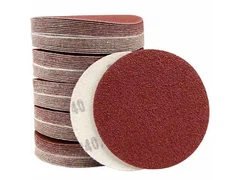How to select sand belts
Mar 02, 2024
Leave a message
The main basis for selecting abrasive belts is the conditions of grinding processing, such as the characteristics of the workpiece being ground, the state of the grinding machine, the performance and technical requirements of the workpiece, production efficiency, etc; On the other hand, the selection also needs to be based on the characteristics of the sand belt.
1. Selection of granularity:
Generally speaking, the selection of abrasive particle size is based on considerations of grinding efficiency and workpiece surface smoothness. Wood should be dry ground, and the particle size range of the selected sand belt is 36-80, 100-150, 180-240
2. Selection of binders: Sandbelts can be divided into four types based on different binders: animal glue sandbelts, namely dry frosted belts, semi resin sandbelts, full resin sandbelts, and water resistant sandbelts. Here we will only discuss the materials used for grinding wood:
(A) Animal glue sand belt is inexpensive, easy to make, and mainly suitable for low-speed grinding.
(B) The semi resin sand belt has improved the shortcomings of animal glue sand belt, such as poor moisture resistance and heat resistance, greatly improving the bonding performance. With little price increase, the grinding performance has doubled.
(C) The all resin sand belt is made of high-quality synthetic resin, high-strength cotton cloth, and superior abrasives, with high cost. However, it has the characteristics of wear resistance and can be used for strong grinding. Capable of handling situations that require high-speed operation, large cutting, and high-precision grinding.
3. Selection of substrate:
Single layer lightweight paper: lightweight, soft, low tensile strength, and low cost. Commonly used for fine or medium grinding, suitable for manual or vibrating sanding machines. Polishing of complex surface workpieces, sanding of curved wooden surfaces, polishing of metal and wooden topcoats, and precision instrument and meter polishing.
Multi layer medium-sized paper: It is thicker, more flexible, and has higher tensile strength than lightweight paper. Used for manual or handheld polishing machines to manufacture sandpaper in the form of sheets or rolls. Rust removal and polishing of metal workpieces, sanding of wooden furniture, polishing of primer and putty, machine polishing of paint surfaces, and polishing of watch cases and instruments.
Multi layer heavy-duty paper: thick, flexible, high tensile strength, low elongation, and high toughness. Manufacturing paper sanding belts for machining purposes. Suitable for drum type sanding machines, broadband sanding machines, and general sanding belt grinders, mainly processing plywood, particleboard, fiberboard, leather, and woodwork.
Lightweight fabric (twill): very soft, lightweight, with moderate tensile strength. For manual use or low load machine use. Metal parts polishing, rust removal, polishing, roller sanding machine plate processing, sewing machine frame processing, light load sanding belt.
Medium fabric (coarse twill): Good flexibility, thick, and high tensile strength. Machine use, general machine use sand belts, and heavy-duty sand belts, such as furniture, tools, electric irons, sand steel sheets, engine blade grinding processing, etc.
Heavy duty fabric (satin pattern): Thick, with higher weft strength than warp strength. Machine use, suitable for heavy-duty grinding. Used for processing large-area sheet metal.
Composite base: Extremely thick, high strength, anti wrinkle, anti tensile, and anti rupture. Machine use, heavy load sanding belt, especially suitable for cutting flower boards, fiberboards, plywood processing, and grinding of inlaid floors.
Steel paper: Especially thick, with high strength, low elongation, and good heat resistance. Machine use, mainly used for sanding plates, welding seams, rust removal, metal skin removal, and oxide layer removal.
Send Inquiry







